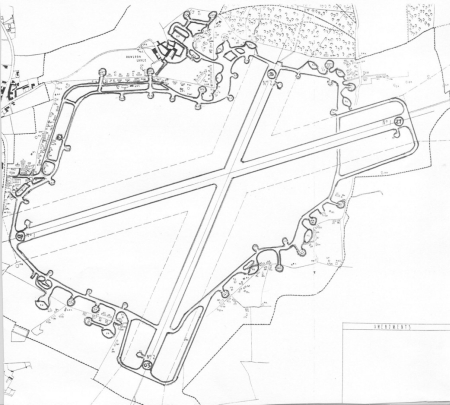 The Air Ministry map of RAF Hunsdon |
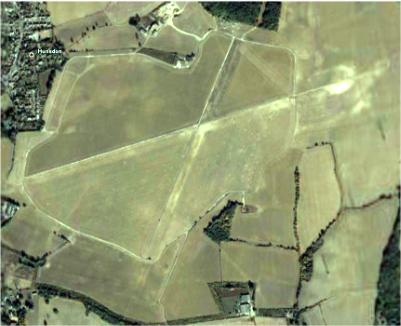 Remaining traces of the airfield |
A sizeable area of farmland to the east of Hunsdon was requisitioned by the Air Ministry in 1939 to provide for additional fighter air defence of London. Construction began in October 1940 and involved removal of significant areas of woodland and field boundaries, as well as the Old Turkey Cock pub and a number of cottages in Acorn street. The base became operational in May 1941.
Sorties from the RAF Hunsdon provided a major contribution to the night time defence of Britain and, once the threat of attack to London had diminished, the primary role turned from defence to attack. The De Havilland Mosquito became the mainstay of its fighter bomber role and contributed to many significant attacks during the later stages of the war. Operation Jericho – the precision bombing raid on Amien Prison to release French Resistance fighters on the eve of their execution – was flown from Hunsdon on 18th February 1944. Click on the “Play” button to watch a new movie about the RAF in Hunsdon. Note you will need a high-speed (broadband) connection because of the file size.
At its height more than 2000 personnel were stationed at RAF Hunsdon, and the lives of the service personnel and of village residents became wholly entwined. Operations from Hunsdon ceased within days of VE Day in May 1945, although it was used to receive personnel and materiel returning from Europe until June 1946. Post war it was returned to agriculture, passing through a number of landowners up until its present owners – Places for People. Although land to the south has been earmarked for housing development in the current District Plan, the airfield itself is to be passed into community ownership.
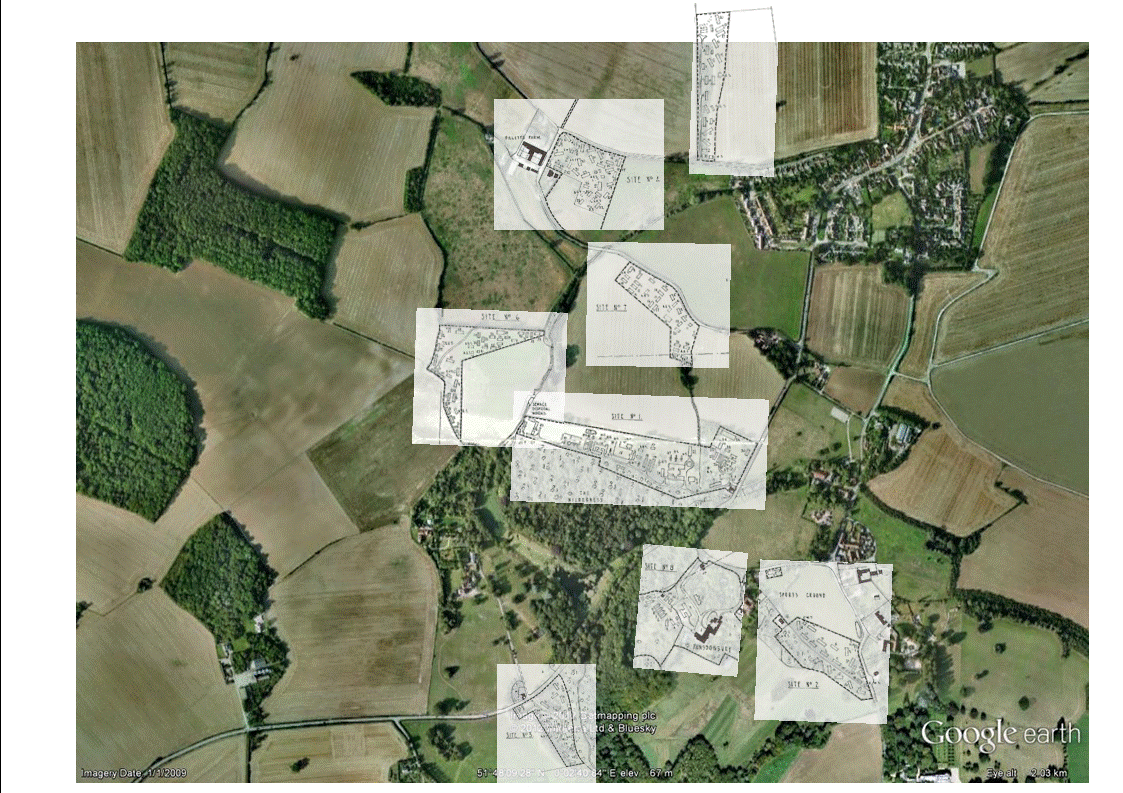 Several books on the wartime history of the RAF refer to the detailed part played by RAF Hunsdon, and there is a good description of Hunsdon’s role at https://www.wartime-airfields.co.uk . Fred and Vera Hitching (long-time residents of Hunsdon) have written an excellent history which focuses on the impact of the airfield on the village (The Royal Air Force at Hunsdon 1941-1945, Published by The Hunsdon Local History and Preservation Society, 1990. ISBN 0-9506633-1-X) – see details about current publication here. This identifies and describes nine sites around Hunsdon in addition to the main airfield itself, and the (modern) aerial picture shown here indicates where these were – and goes some way to explain the various odd structures (or remains thereof) still visible about the village. Click on the picture for a full-size image. Hunsdon airfield is also recorded by the Airfields of Britain Conservation Trust http://www.abct.org.uk
Several books on the wartime history of the RAF refer to the detailed part played by RAF Hunsdon, and there is a good description of Hunsdon’s role at https://www.wartime-airfields.co.uk . Fred and Vera Hitching (long-time residents of Hunsdon) have written an excellent history which focuses on the impact of the airfield on the village (The Royal Air Force at Hunsdon 1941-1945, Published by The Hunsdon Local History and Preservation Society, 1990. ISBN 0-9506633-1-X) – see details about current publication here. This identifies and describes nine sites around Hunsdon in addition to the main airfield itself, and the (modern) aerial picture shown here indicates where these were – and goes some way to explain the various odd structures (or remains thereof) still visible about the village. Click on the picture for a full-size image. Hunsdon airfield is also recorded by the Airfields of Britain Conservation Trust http://www.abct.org.uk
In recent years there have been a number of initiatives to ensure the history of RAF Hunsdon, and of the service given by the airmen and airwomen who were stationed there, should be remembered. In November 1995, a Mr F L Jones of Hoddesdon wrote to the Parish Council to suggest that a memorial in the form of a rustic bench should be erected in the Village, to commemorate, in his words, the Royal Canadian Air Force personnel who served at RAF Hunsdon during World War II. After discussion, the Parish Council felt that the matter should be left in abeyance since a number of commemorative benches in the Village had been vandalised, and it was likely that another bench would suffer the same fate.
However, in January 1977, the Parochial Church Council agreed that a memorial of some sort should be erected – probably in the form of a memorial plaque fixed to the Village Hall – but that it should be dedicated to the men and women of all air forces who served at RAF Hunsdon. A member of the PCC, Steven Brereton Martin (a retired RAF Group Captain) undertook to form and chair a RAF Hunsdon Memorial Committee to take the matter forward. Joining the RAF Hunsdon Memorial Committee were Councillor Mrs Helen Brown, representing the Parish Council, Mr Fred Hitchin (author of a booklet on the history of RAF Hunsdon) representing the Local History and Preservation Society and Mr John Glazebrook, subsequently Mr Geoff Hainsworth, represented the Village Hall Management Committee. The Village Hall was selected as the most suitable site for the memorial since it is central to the Village, but also because the Remembrance Sunday service and commemoration is held in the Hall each year. However, it is a listed building, and this required specific permissions to be granted before plans could be put into effect. Fund raising was achieved through the local press, but also through the squadron associations and the Mosquito Aircrew Association. Donations were received from the local area as well as from far afield as New Zealand. A total of £1,015.74 was raised. The plaque, in slate, and bearing the RAF badge and (in view of the Allied air forces involved) the badge of the RAF Air Forces Association was commissioned from J Day & Sons of Bishops Stortford. Final approval was received from the relevant authorities by August 1998 and it was agreed that the plaque should be unveiled on Remembrance Sunday, 8th November 1998. In view of the fact that No 85 Squadron RAF was the longest-serving RAF squadron to operate from RAF Hunsdon, it was appropriate that Group Captain John Cunningham CBE, DSO, DFC AE, DL agreed to unveil it, since John “Cat’s Eyes” Cunningham had commanded No 85 Sqn RAF on operations from RAF Hunsdon; he later became a world-renowned test pilot. When all costs of the project had been met, a balance of £228.49 remained and the RAF Hunsdon Memorial Committee agreed that this should be donated to the Royal Air Forces Association to support its welfare activities.
In front of the Village Hall from l to r are:
Gp Capt Steven Brereton Martin CBE RAF (Ret’d), Hunsdon PCC
The Rev John Risby, Rector of St Dunstan’s Hunsdon
Gp Capt John Cunningham CBE DSO DFGC DL RAF (Ret’d)
Mr K V Lupton, Vice President Hertford and District Branch Royal Air
Forces Association
 |
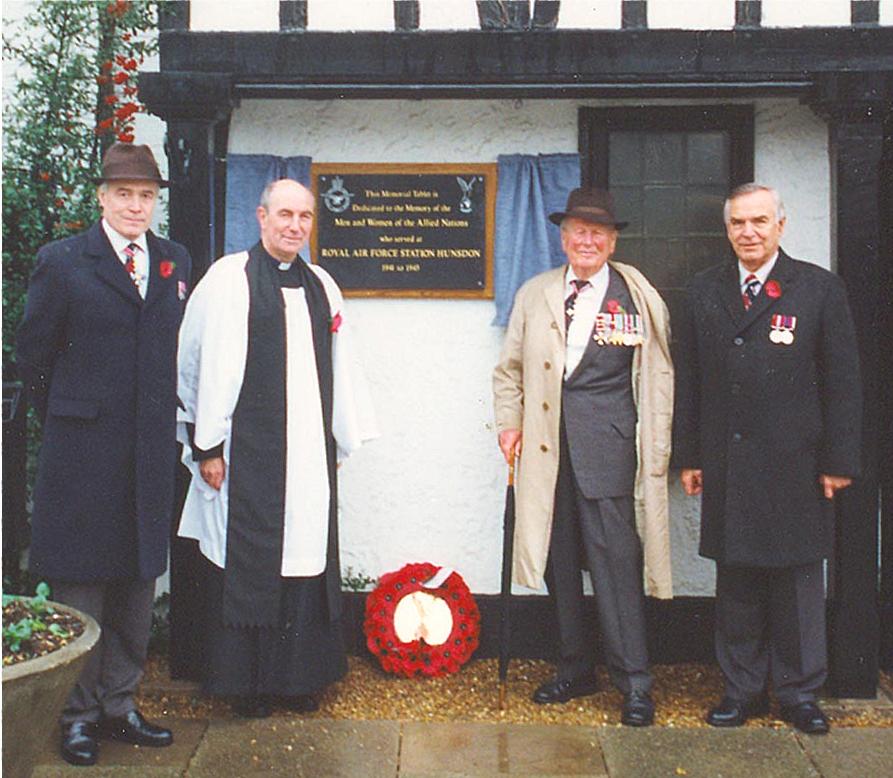 |
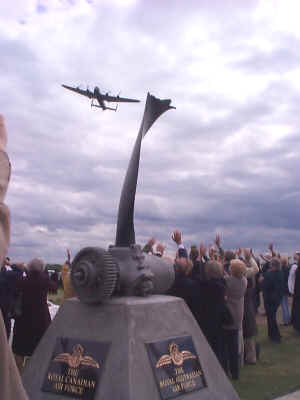 Lancaster flypast during dedication of the airfield memorial
Lancaster flypast during dedication of the airfield memorial
In 2003 a group of individuals formed with the intent of erecting a memorial on the airfield itself. The initiative came to fruition in 2005 when the memorial was completed and dedicated in a well-attended service that saw several veteran airmen and airwomen return for the first time to RAF Hunsdon. The full story of the planning, execution and dedication of the memorial is told by the Hunsdon Airfield Memorial Group http://hamg.co.uk/RAF-Hunsdon.php. Read more about the HAMG memorials and Operation Jericho here